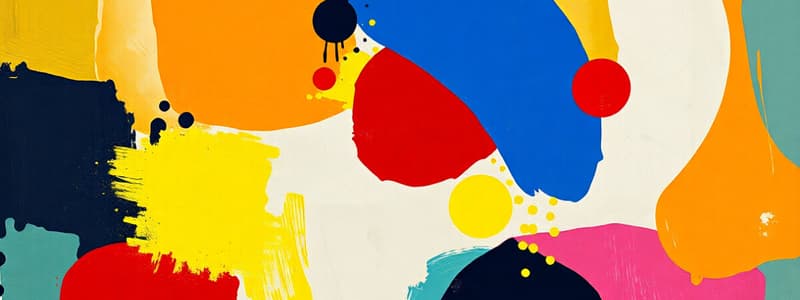Podcast
Questions and Answers
Which art element is most concerned with the arrangement of objects to create depth and distance in a composition?
Which art element is most concerned with the arrangement of objects to create depth and distance in a composition?
- Texture
- Value / Tone
- Space (correct)
- Form
Which property is NOT typically associated with 'Line' as an element of art?
Which property is NOT typically associated with 'Line' as an element of art?
- Character
- Measurement
- Direction
- Volume (correct)
The property that describes the purity or saturation of a color is known as what?
The property that describes the purity or saturation of a color is known as what?
- Intensity (correct)
- Tone
- Value
- Hue
What distinguishes a shape from a form in art?
What distinguishes a shape from a form in art?
In the context of 'Space', what distinguishes 'Aerial Perspective' from 'Linear Perspective'?
In the context of 'Space', what distinguishes 'Aerial Perspective' from 'Linear Perspective'?
Flashcards
Line
Line
A mark or path moving between two points.
Shape
Shape
When a line encloses a space; it can be 2-D or 3-D.
Form
Form
A 3-D object with height, width, and depth.
Space
Space
Signup and view all the flashcards
Texture
Texture
Signup and view all the flashcards
Study Notes
Art Elements
-
Line: A mark or path moving between two points.
- Physical properties include measurement, direction, location, character, and expressiveness.
- Examples of properties include long, horizontal, outline, and geometric.
-
Shape: A line enclosing a space.
- Two-dimensional (2-D): Measured by height and width.
- Three-dimensional (3-D): Two-dimensional shape with depth added.
- Geometric: Precise measurements and size.
- Organic: Irregular measurements and size.
-
Form: Three-dimensional.
- Refers to an object with volume.
-
Space: Perspective and proportion between objects.
- Divided into foreground, middle ground, and background.
- Shallow space vs. deep space: Close objects vs. distant objects.
- Positive space: The space occupied by objects(s).
- Negative space: The area around and between objects.
- Perspective: Creates depth through a vanishing point on the horizon.
- Aerial perspective: Close objects are clear; far objects are less clear/fuzzy.
- Linear perspective: Vertical lines remain vertical; horizontal lines change based on the viewer's position.
-
Colour:
- Hues: Distinct colors.
- Intensity: The strength or weakness of a color.
- Value: The lightness or darkness of a hue.
-
Value/Tone: The lightness or darkness of tones in an image.
-
Texture: The surface quality of an artwork.
- Can be tactile (real) or visual (implied).
Studying That Suits You
Use AI to generate personalized quizzes and flashcards to suit your learning preferences.




